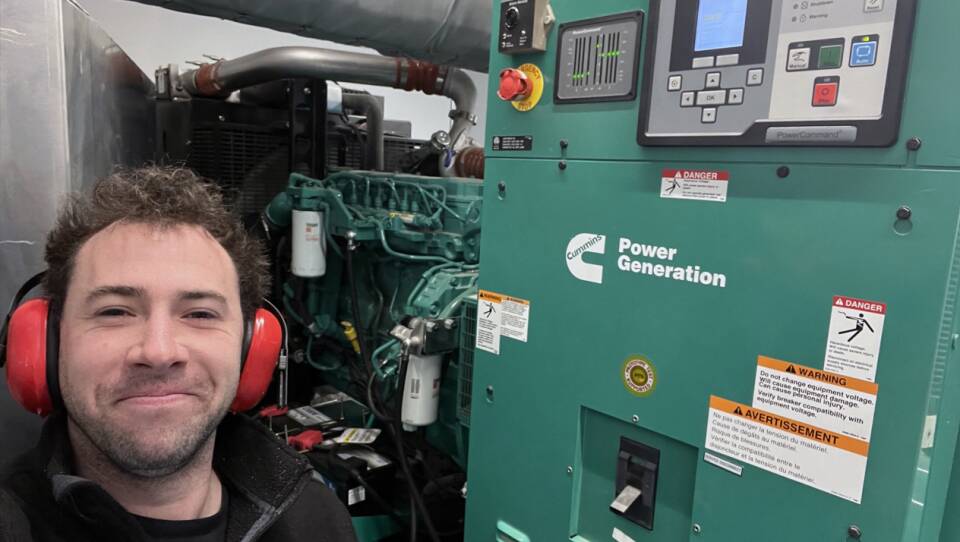Planes, ferries, bikes and jeeps. These are the ways GBH Transmitter Engineer Christopher Kelly gets around to upkeep six GBH radio transmitters and three studios spread across the eastern half of Massachusetts. These transmitters vary in location, power, history and station. At GBH, the audio signals from the studios are sent out from Guest Street in Brighton through fiber, microwave, IP and satellite dishes. Then, transmitters pick up the signals and send out radio waves across a wide radius.
Kelly learned early on in his career that the sedentary nature of a desk job was not for him. Instead, he desired a profession with constant movement, fluidity and problem solving. He is always on call and ready to fix a disturbance to the radio airwaves, such as from severe weather storms, flooding, construction or technical hiccups. Even with these hurdles, Kelly provides seamless radio coverage.

With the recent reopening of Great Blue Hill’s weather observatory and its ties to GBH’s first radio broadcast, we spoke with Kelly to get an inside look at each of the transmitter sites and their unique personalities.
The Historical Powerhouse of Radio

The transmitter for WGBH 89.7 is located on top of Great Blue Hill, the tallest point in eastern Mass. (and the origin of GBH’s name). Three years after the Civil War, there was a weather observatory there, the building where GBH aired its first radio broadcast in 1951 in the basement with an FM transmitter borrowed from Edwin Howard Armstrong, who invented FM radio.
Fast-forward to the present, and GBH has one of the most powerful non-commercial radio transmitters in the country - about 100,000 kilowatts (enough to power about 50 homes).
Aside from the sheer power and history, the transmitter’s location has a beautiful scenic view. “I can see Boston, Connecticut and Rhode Island,” Kelly says, “There are hikers and visitors who come to see the view and weather observatory. Then, there’s this huge radio tower looming above, so people are always surprised and curious.”
A Home Among the Classical Mansions

To maintain the CRB Classical 99.5 transmitter, Kelly drives up a hill in Andover, Mass. into a dead-end cul-de-sac populated with mansions. Next to all the luxury homes is an Art Deco, 1970s house. “From both an engineering and comfortability standpoint, it’s a nice site,” Kelly explains, “There are two generators, battery backups, a kitchenette, a shower - it’s practically a bomb shelter where one can live.”
CRB sends audio signals to the transmitter via fiber line. Not too long ago, a construction crew dug a hole somewhere along the path and ripped out that fiber, so it cut the signal. All of the sites have notification systems in place that will email, text or call Kelly when there are technical issues. When this line got cut, he was driving out to western Mass. to Tanglewood. “Ten minutes into the drive, my phone rings,” Kelly recalls, “I pulled over, got out my laptop, and luckily, I can fix things remotely to employ the backup systems in place.”
Coastal Coverage on the Cape

For Kelly, the Cape Cod station holds a special place in his heart. He lived in Falmouth after graduating college, so he’s known most of the employees for years prior to working at GBH.
CAI, GBH’s Cape, Coast and Islands radio service, has three transmitters spread across the Cape and Islands (Brewster, Martha’s Vineyard and Nantucket) that all share the same audio.
The transmitters at these sites are less powerful compared to the one on Great Blue Hill. In order to get the radio signal to cover a large area, CAI uses three small transmitters.
To reach one of the transmitter sites on Martha’s Vineyard, Kelly’s commute consists of a ferry ride followed by a half-mile bike ride. Near the ferry dock, Kelly routinely stops by the CAI studio and his favorite bakery “Pie in the Sky.” For the transmitter on Nantucket, Kelly heads to Logan Airport to board a Cessna for a quick 15-minute trip to the island.
“Most people don’t take a tiny plane to work.” Listen to GBH 89.7, CRB Classical 99.5 and CAI.





